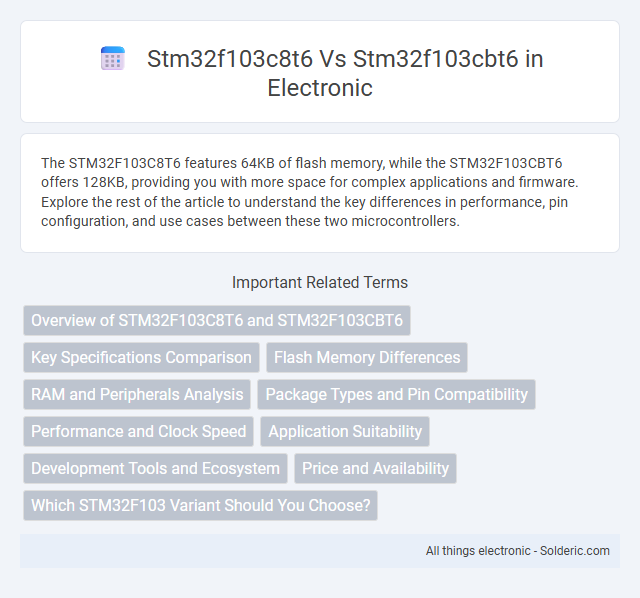The STM32F103C8T6 features 64KB of flash memory, while the STM32F103CBT6 offers 128KB, providing you with more space for complex applications and firmware. Explore the rest of the article to understand the key differences in performance, pin configuration, and use cases between these two microcontrollers.
Comparison Table
| Feature | STM32F103C8T6 | STM32F103CBT6 |
|---|---|---|
| Core | ARM Cortex-M3, 72 MHz | ARM Cortex-M3, 72 MHz |
| Flash Memory | 64 KB | 128 KB |
| SRAM | 20 KB | 20 KB |
| Package | LQFP48 | LQFP48 |
| GPIO Pins | 37 | 37 |
| ADC Channels | 10 | 10 |
| Timers | 3x 16-bit, 1x SysTick | 3x 16-bit, 1x SysTick |
| Communication Interfaces | 2x USART, 2x SPI, 1x I2C, 1x CAN | 2x USART, 2x SPI, 1x I2C, 1x CAN |
| Operating Voltage | 2.0 to 3.6 V | 2.0 to 3.6 V |
| Price Range | Lower (due to 64 KB Flash) | Higher (due to 128 KB Flash) |
Overview of STM32F103C8T6 and STM32F103CBT6
STM32F103C8T6 and STM32F103CBT6 microcontrollers both belong to the STM32F1 series by STMicroelectronics, featuring ARM Cortex-M3 cores operating at 72 MHz. The STM32F103CBT6 variant offers increased flash memory capacity of 128 KB compared to the 64 KB in STM32F103C8T6, supporting more complex applications and firmware. Both models include identical peripherals such as ADCs, timers, and communication interfaces, but the enhanced memory size in the CB variant is a key differentiator for advanced embedded system designs.
Key Specifications Comparison
The STM32F103C8T6 features a 64 KB Flash memory and 20 KB SRAM, while the STM32F103CBT6 provides a larger 128 KB Flash memory and 28 KB SRAM, enhancing program storage and data handling capacity. Both microcontrollers operate at up to 72 MHz with the ARM Cortex-M3 core, offering similar clock speeds and core performance. They include identical peripherals such as multiple USARTs, SPI, I2C interfaces, and 12-bit ADCs, but the STM32F103CBT6's increased memory makes it better suited for more complex and memory-intensive applications.
Flash Memory Differences
The STM32F103C8T6 features 64 KB of Flash memory, while the STM32F103CBT6 offers a larger 128 KB Flash memory capacity, enabling more extensive program storage and complex applications. Both microcontrollers maintain similar core specifications, but the increased Flash size in the STM32F103CBT6 provides greater flexibility for firmware updates and enhanced code density. Your choice between the two will depend on your project's memory requirements and future scalability needs.
RAM and Peripherals Analysis
The STM32F103CBT6 offers 48KB of RAM compared to the STM32F103C8T6's 20KB, providing more memory for complex applications and improved data handling. Peripheral-wise, both MCUs feature identical configurations, including timers, ADC channels, and communication interfaces such as USART, SPI, and I2C, ensuring similar functionality. Your choice depends on whether the additional RAM is crucial for your project's performance requirements.
Package Types and Pin Compatibility
The STM32F103C8T6 features a 48-pin LQFP package, while the STM32F103CBT6 comes with a 64-pin LQFP package, offering more I/O pins and greater peripheral flexibility. Despite differences in pin count, both microcontrollers maintain high pin compatibility with shared functions on overlapping pins, facilitating easier migration between models. The expanded package of the STM32F103CBT6 supports additional features such as extra USART, ADC inputs, and general-purpose I/O pins, making it ideal for more complex embedded applications.
Performance and Clock Speed
The STM32F103CBT6 offers a higher maximum clock speed of up to 72 MHz compared to the STM32F103C8T6's 64 MHz, enhancing overall processing performance. Both microcontrollers are based on the ARM Cortex-M3 core, but the increased clock speed in the CBT6 variant supports more efficient handling of demanding applications. Your choice between these models will impact the speed at which your embedded system executes tasks and processes data.
Application Suitability
The STM32F103C8T6 suits applications requiring moderate memory and peripheral integration, featuring 64KB flash and 20KB RAM optimal for general-purpose embedded systems and IoT devices. The STM32F103CBT6 offers enhanced application suitability with 128KB flash and 28KB RAM, supporting more complex firmware and data processing tasks in industrial control, motor control, and real-time signal processing. Both microcontrollers efficiently handle communications like USART, SPI, and I2C, but the CB variant better accommodates higher code density and advanced application demands.
Development Tools and Ecosystem
The STM32F103C8T6 and STM32F103CBT6 microcontrollers both support a robust development ecosystem primarily based on the STM32CubeMX software suite and HAL libraries, which simplify peripheral configuration and code generation. You will find extensive compatibility with popular IDEs like Keil MDK, IAR Embedded Workbench, and open-source toolchains such as STM32CubeIDE and PlatformIO, ensuring seamless integration regardless of your development preferences. The main difference lies in memory capacity, with the CBT6 variant offering 128 KB flash compared to 64 KB on the C8T6, influencing project scalability and firmware complexity in your application development.
Price and Availability
The STM32F103C8T6 microcontroller is generally more affordable and widely available due to its popularity and higher production volumes, making it a cost-effective choice for many applications. In contrast, the STM32F103CBT6, featuring a larger memory capacity, tends to be priced higher and may have slightly less market availability. Procurement decisions often weigh the price difference against the memory requirements and supply chain status for both models.
Which STM32F103 Variant Should You Choose?
The STM32F103CBT6 features 128KB of flash memory compared to the STM32F103C8T6's 64KB, offering doubled storage for more complex applications and data. Both variants share the same Cortex-M3 core, 72 MHz clock speed, and peripheral set, making performance largely equivalent beyond memory size. Choose the STM32F103CBT6 if your project demands increased program space, while the STM32F103C8T6 suits simpler, cost-sensitive designs.
stm32f103c8t6 vs stm32f103cbt6 Infographic

 solderic.com
solderic.com